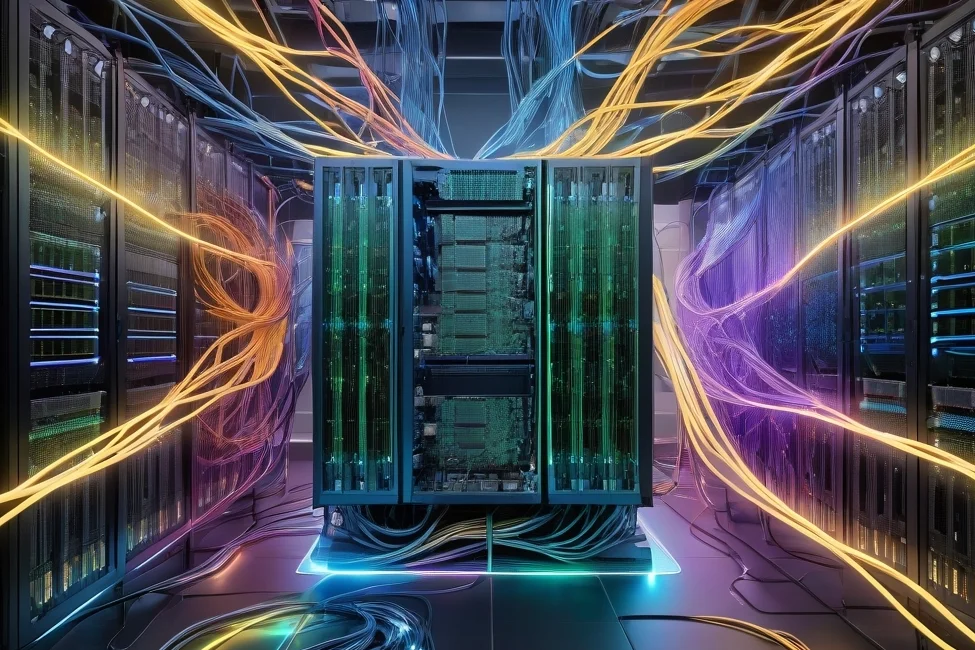
Artificial Intelligence isn’t just changing the way we live and work, it’s igniting an unprecedented boom in AI infrastructure investment all over the world. According to recent projections, AI infrastructure spending is estimated to reach up to $4 trillion by 2030. Fueling this surge, tech giants are setting aside hundreds of billions of dollars to expand their AI computing capacity, build new data centers, and upgrade networks.
AI Infrastructure as the Next Big Asset Class
So what’s driving this wave? At its core, it’s the growing need for specialized AI hardware, software, and physical facilities required to power today’s sophisticated AI applications. While traditional IT infrastructure is designed for general computing tasks, AI infrastructure is purpose-built for enormous parallel computations and massive datasets. Because of this, major cloud providers and chip manufacturers are in a race to deliver the massive computing power these applications demand.
NVIDIA’s recent $5 billion investment in rival Intel affirms this positioning. From their partnership, Intel will build NVIDIA-custom x86 CPUs that NVIDIA will integrate into its AI infrastructure platforms.
Understanding AI Architecture
As discussed, AI infrastructure includes hardware and software specifically designed for AI workloads like machine learning. Specialized processors, high-performance servers, state-of-the-art data centers, fast data storage, and the lightning-quick networks are all necessary due to the high data and computation demands of AI models. These components form the backbone of the AI revolution, enabling rapid data processing and effective model training at scale.
Compute Power
Source: AI-Generated by Andre Bourque
Among the various components of AI infrastructure, compute power stands out as the foundational element enabling the rapid advancements in machine learning and artificial intelligence. Compute power refers to the raw processing capability required to handle complex mathematical operations, data analysis, and neural network computations. It is, quite literally, the chip-fueled engine behind modern AI transformations.
Different machine learning models require distinct types of processors for optimal efficiency. Central Processing Units (CPUs), long the workhorse of traditional computing, often handle simple or sequential tasks but lack the high-throughput needed for deep learning models. Graphics Processing Units (GPUs) have become the standard for many AI applications, thanks to their ability to perform massive numbers of calculations in parallel, ideal for tasks like image recognition, language processing, and model training at scale. These GPUs, originally developed to enhance video game graphics, now underpin data centers and cloud services powering global AI innovation.
Specialized processors are also emerging to meet the unique demands of AI. Tensor Processing Units (TPUs), engineered by Google, are custom-designed to accelerate tensor operations, the mathematical backbone of neural networks, significantly outperforming traditional GPUs for certain deep learning tasks. Similarly, other companies are racing to develop their own AI-specific chips tailored to minimize latency and maximize throughput for inference and training.
The immense and growing demand for AI compute is reflected in the explosive growth forecast for the AI chips market that is expected to surge from $84 billion in 2025 to $459 billion by 2032, representing a compound annual growth rate of 27.5%.
Source: Coherent Market Insights
Data Centers
Global spending on AI-specific data centers alone could top $1.4 trillion by 2027. These integral infrastructure pieces include hyperscale data centers and edge data centers.
Hyperscale data centers are massive facilities that accommodate thousands, often tens of thousands, of servers under one roof. These centers are engineered for maximum computational power and efficiency, making them ideal for supporting the intensive processing demands required during AI training workflows. Hyperscale data centers often belong to tech giants or cloud providers, offering abundant storage capacity, powerful networking, and robust redundancy. Their vast computing infrastructure forms the backbone for building and scaling large-scale AI models, enabling breakthroughs in areas like natural language processing and image recognition.
In contrast, edge data centers are strategically located closer to end users and devices. Their primary advantage is reduced latency, which is crucial for real-time analytics, fast response times, and delivering seamless digital experiences. While smaller in scale compared to hyperscale centers, edge data centers play a pivotal role in supporting AI applications that require immediate data processing, such as autonomous vehicles, industrial automation, and smart cities. By bringing computation nearer to the data source, edge data centers help optimize performance and reliability for a rapidly growing range of AI-powered services.
Networking Infrastructure
Fast and reliable networking infrastructure is essential to support the vast flows of data required by modern AI systems. As artificial intelligence relies heavily on accessing, transferring, and processing large datasets, robust networks ensure that data can move efficiently between devices, data centers, and cloud platforms. High-speed connections reduce bottlenecks and enable the seamless scaling of AI workloads essential for applications in research, finance, healthcare, and beyond.
This infrastructure is so critical to AI processing, in fact, that the global AI in networks market, once estimated at $8.67 billion in 2023, is projected to reach $60.60 billion by 2030, growing at a CAGR of 32.5% from 2024 to 2030.
Source: Grand View Research
The advent and deployment of advanced technologies such as 5G networks has further transformed the landscape. 5G delivers significantly higher speeds and lower latency compared to previous generations, making it possible to support real-time AI applications across a variety of industries. From autonomous vehicles and smart factories to connected healthcare devices and immersive retail experiences, 5G enables more responsive and intelligent digital solutions, driving innovation and expanding the reach of AI-powered services into new domains.
Looking ahead, investment in reliable next-generation networks like satellite internet and 6G is poised to play a critical role in shaping AI infrastructure. Satellite internet can bridge connectivity gaps in remote and underserved regions, enabling global participation in the AI revolution. Meanwhile, the promise of 6G lies in its potential for even faster speeds, lower latency, and more secure connections, which will be essential as AI-driven demands continue to grow. Strategic support for these networking technologies is vital to unlocking the full potential of AI and ensuring robust, inclusive digital ecosystems worldwide.
Cloud Services and Infrastructure
The global cloud computing market was estimated at $752.44 billion in 2024, and is projected to reach approximately $2.39 trillion by 2030, growing at a compound annual growth rate (CAGR) of 20.4%. Major cloud providers like Amazon Web Services (AWS), Google Cloud, and Microsoft Azure are rapidly expanding their AI-focused infrastructure to meet the growing demands of artificial intelligence applications. These companies are investing heavily in building out global networks of data centers equipped with the latest technologies to handle the computational intensity of AI workloads. By doing so, they are positioning themselves at the forefront of the AI infrastructure market and enabling enterprises and developers to tap into cutting-edge resources without having to build or manage physical systems themselves.
Cloud solutions offered by these providers have transformed how organizations access and utilize AI technology. Instead of making substantial upfront investments in on-premises hardware, enterprises can now rent compute power as needed, scaling resources up or down based on project requirements. This has effectively democratized access to high-performance AI tools, empowering a wide range of organizations, from startups to multinational corporations, to experiment with and deploy AI-driven solutions at unprecedented scale and speed.
AI Model Training and Storage Solutions
Efficient training of AI models increasingly relies on distributed computing techniques, which allow complex tasks to be split and processed across multiple GPUs simultaneously. By leveraging a network of interconnected processing units, organizations can accelerate the training of large and sophisticated AI models, significantly reducing time to deployment. This parallelization is essential as AI models continue to grow in size and complexity, requiring enormous computational resources to achieve optimal performance.
Equally important are robust data storage solutions, such as large-scale data lakes, which are designed to handle the vast volumes of unstructured data needed for AI model training. These expansive storage systems enable the ingestion, management, and retrieval of diverse data types, ranging from text and images to audio and video. Properly managed data lakes ensure that AI systems have ready access to the comprehensive datasets required for training, supporting better model accuracy, scalability, and adaptability in real-world applications.
The market for these AI data solutions is growing at monumental speeds. The global AI-powered storage market valued at $27.06 billion today, is projected to reach $76.6 billion by 2030, growing at a CAGR of 23.13%.
Source: Mordor Intelligence
As the demand for advanced AI model training and storage solutions accelerates, driven by ever-growing data volumes and compute requirements, the companies providing this critical infrastructure are becoming increasingly central to the broader AI ecosystem. This surging need presents a compelling opportunity for investors to consider stakes in firms at the forefront of AI infrastructure, as their technologies underpin both current innovations and the future growth trajectory of artificial intelligence worldwide.
Capitalizing on the Backbone: Opportunities in AI Infrastructure Companies
Source: AI-Generated by Andre Bourque
AI infrastructure serves as the foundational technology driving today’s major digital and business transformations. As the appetite for digital solutions grows, so does the importance and value of secure, scalable infrastructure. This significance is amplified by AI’s anticipated $15.7 trillion boost to global GDP by 2030, a 14% rise relative to a world without AI.
These factors combine to make AI infrastructure an attractive investment. However, successful investing in this sector demands a curious mindset, thorough research, and a willingness to embrace calculated risks, especially as both opportunities and competition intensify.
Consider Diversification
First, diversification in AI infrastructure investment is essential. Avoid concentrating exposure in just one segment, such as only compute or only data centers, instead, target a balanced mix across compute hardware, data center operations, and cloud platforms. This approach helps mitigate segment-specific risks and positions you to benefit from the broad, interconnected growth of the AI ecosystem.
Aim for Sustainable Advantages
As you evaluate potential investments, prioritize companies that exhibit strong competitive moats and sustained innovation. Seek out firms with cutting-edge engineering talent, proprietary technologies that are difficult to replicate, and well-defended supply chains. These attributes are critical for long-term resilience, enabling organizations to outpace rivals as the AI landscape evolves.
Prioritize Scalability
Finally, give preference to providers that demonstrate clear scalability. Favor businesses that are actively expanding their geographical footprint, rapidly growing their customer base, and developing robust, flexible cloud ecosystems. Companies with adaptable service offerings are best equipped to serve the evolving demands of AI workloads and stand to capture significant market share as enterprise adoption accelerates.
Sector Risks & Considerations
Investing in AI infrastructure comes with unique sector risks that require careful consideration.
Energy Dependence
One of the most pressing is the significant energy and environmental impact associated with AI compute workloads, what I refer to as “Tomorrow’s Energy Crisis” in an earlier article. AI power demand is predicted to surge 550% by 2026, before rising to what will represent 16% of current U.S. electricity demand by 2030. Because AI infrastructure is power-hungry, investors should scrutinize companies’ sustainability commitments and their initiatives toward energy efficiency to ensure long-term operational viability and compliance with emerging environmental standards.
Source: Wells Fargo
Pace of Innovation
Another critical factor is the rapid pace of innovation in AI technologies. The sector evolves quickly, and today’s market leaders can lose their advantage if they fail to keep up with emerging technologies or shifting industry standards. Ongoing diligence is required to stay informed of new developments and continually assess whether portfolio companies maintain a competitive edge.
Regulatory and Supply Chain Uncertainties
Additionally, AI infrastructure companies face regulatory and supply chain uncertainties, particularly in hardware production. Geopolitical tensions and global supply chain disruptions can impact access to essential components and delay project timelines. Investors should evaluate companies’ risk management strategies and adaptability in navigating these external challenges.
Actionable Steps for New Investors
For those new to AI infrastructure investing, a strategic starting point may be to consider AI sector-focused Exchange-Traded Funds (ETFs) and even nuclear sector ETFs. These investment vehicles offer immediate diversification, providing exposure to a broad range of industry leaders across compute, data centers, and cloud services, which helps mitigate individual company risk and capture sector-wide growth. Some examples include:
Global X Artificial Intelligence and Technology ETF AIQ stands out among leading AI ETFs, providing exposure to approximately 90 companies across sectors such as semiconductors, data infrastructure, and software.
Global X Robotics and Artificial Intelligence ETF (Nasdaq BOTZ) targets investments in firms involved in robotics, artificial intelligence, and automation technologies.
iShares Future AI and Tech ETF ARTY grants investors access to 48 international companies focused on AI infrastructure, cloud platforms, and machine learning advancements.
Staying informed is equally important. Make it a routine to monitor industry news, including quarterly earnings reports, announcements of new data center developments, and updates on hardware roadmaps from major players, and, of course, my column. This vigilance will help you identify emerging trends, spot potential disruptors, and react promptly to market shifts.
Finally, maintain a commitment to ongoing research with a portfolio that balances established public companies and promising private firms. Deepen your understanding of each company’s market position, technology pipeline, and growth prospects by analyzing financials, management commentary, and independent industry analysis—bolstering your ability to make informed, confident investment decisions in this dynamic sector.
Investing in AI infrastructure involves understanding both the current landscape and anticipating the rapid shifts influenced by technology progress and market demand. The companies above provide a solid starting point for building knowledge and exposure in this critical sector.
Feature Image: AI-Generated by Andre Bourque



